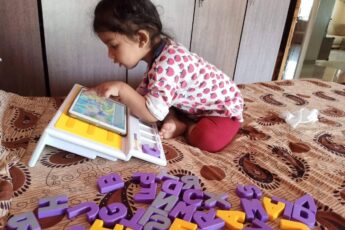3 Easy Activities For Reading Readiness

Children are not born knowing how to read; in fact, it is a learned skill. Yet, it is one of the foundations on which other academic learning is based. The benefits of reading at each stage in a child’s life are well documented. So, how do you help your children along the path to reading readiness? We have some innovative and easy activity suggestions to enhance foundational English literacy and reading readiness in your children:
FOR CHILDREN JUST BEGINNING TO LEARN THEIR LETTERS
‘The Bird Nest’ – Identify The Short Vowel Sound:
*Short vowel sounds are vowels (in words) that have a short sound, usually different from the way the actual vowel is pronounced. For example, words like ‘ten’, ‘cat’, ‘yet’, all have vowels with short sounds, that don’t sound like the vowel itself.
In multiple small corners of your home, create ‘bird nests’, using lots of blankets, pillows, and even colourful scarves. Assign a letter to each ‘nest’ (for children who have already learnt their letters, you can even write the letter on a paper and place it near the designated ‘nest’). Call out a letter sound. Your child has to correctly identify the letter, and step into the corresponding ‘nest’.
NOTE: You can even simply designate small corners of your home as ‘nests’, without the physical materials, if needed.

FOR CHILDREN WHO ARE LEARNING THEIR LETTERS, AND THOSE WHO CAN READ SMALL WORDS TOO
Pumpkin Bowl – Play And Learn Word Families:
Use orange coloured paper or paint on two large bowls, so they resemble pumpkins. No orange colour OR paper? No problem! Simply use sticky notes to represent the colour you want.
For Beginner Readers: Cut out pictorial representations of common CVC words like ‘MAT’, ‘CAT’, ‘MAN’, ‘PAN’, and ask your child to sort the common sounding words into the same bowl. So, the images of ‘CAT’ and ‘MAT’ go into one bowl, and ‘MAN’ and ‘PAN’ go into the other. Once they have mastered this, you can further boost their phonological awareness by asking them to sort images based on the initial sounds of words, like ‘TAP’ and ‘SAP’.
For Slightly Advanced Readers: Write a different word family (like -AT, -OG) on the side of each bowl. Write various words belonging to these word families (like HAT-FAT, or DOG-FOG) on paper (in keeping with the pumpkin theme, these can also be orange coloured). Have your kids read out the words, figure out which word family the words belong to, and put the paper in the correct bowl.

FOR CHILDREN WHO CAN READ SMALL WORDS
Consonant-Vowel-Consonant (CVC) Word Box:
Turn any old box, like a delivery box, into a word box. Add in tactile (something you can touch and hold) letter shapes, like the Smart Letters from our Square Panda early learning system (or you can create your own letters too, using craft material). Add a few commonly used letters like ‘A’, ‘M’, ‘N’, and ‘P’ into the box. Keeping these letters in mind, say a CVC word out loud (like ‘NAP’), and ask your child to spell it using the letters from inside the word box. At a higher level, they can even be asked to create their own CVC words, or rhyming words, using any letters from the word box.

Loved these early reading activities? Tell us how much in the comments below.
Spread the learning; share this article with other friends and parents who would love to try out these activities.




Leave a Comment